Volatile organic metabolites and their importance in Senecio L. (Senecioneae: Asteraceae)
DOI:
https://doi.org/10.3126/botor.v10i0.21018Keywords:
chemotaxonomy, hexane fraction, secondary metabolites, taxonomic marker.Abstract
The present work aims to characterize volatile secondary metabolites in Senecio L. for delimiting taxa at the infrageneric level. Analysis of n-hexane fraction of ethanolic extracts of five species of Senecio L. (S. laetus Edgew., S. nudicaulis Buch.-Ham. ex D. Don, S. raphanifolius Wall. ex DC., S. royleanus DC. and S. scandens Buch.-Ham. ex D. Don) from Nepal Himalaya revealed the presence of a number of volatile secondary metabolites. Among them, 17 metabolites, viz., acorenol, bergamotene, cadin, cadinene, calarene, caryophyllene, cumialdehyde, cycloprop(e)azulene, elemol, farnesene, hexanol, intermedeol, muurolene, naphthalene, naphthalenone, propenoic acid and tridecane were considered for their potential use in chemotaxonomy of the genus. All species were characterized by the presence of cadin, elemol, farnesene, muurolene, naphthalenone and propenoic acid and absence of acorenol, cycloprop(e)azulene, hexanol and intermedeol. Cumialdehyde is present in all species except S. royleanus; cadinene is present in all tested species except S. nudicaulis and S. royleanus. Moreover, S. nudicaulis can be delimited from other species by the presence of bergamotene; S. royleanus can be delimited from other species by the presence of tridecane and caralene. Caryophyllene is present in S. raphanifolius and S. scandens and absent in S. laetus. Naphthalene is present in S. nudicaulis, S. royleanus and S. scandens, and absent in S. laetus and S. raphanifolius. Presence and absence of a single metabolite or a group of volatile organic metabolites indicates its significance as the taxonomic marker for delimiting taxa at infrageneric level. An artificial dichotomous key is prepared to delimit the taxa.
Botanica Orientalis – Journal of Plant Science (2016) 10: 12–18
Downloads
Downloads
Published
How to Cite
Issue
Section
License
This license enables reusers to copy and distribute the material in any medium or format in unadapted form only, for noncommercial purposes only, and only so long as attribution is given to the creator.




